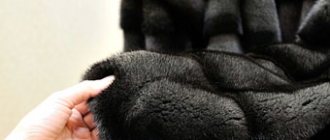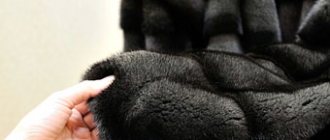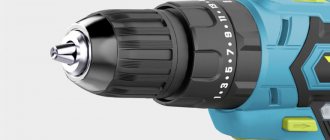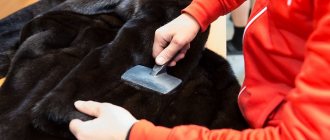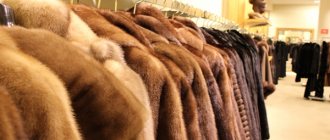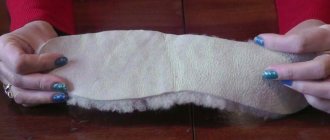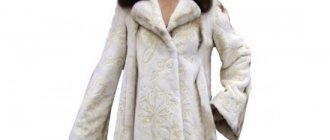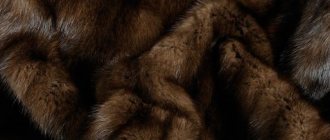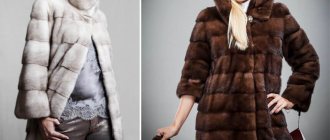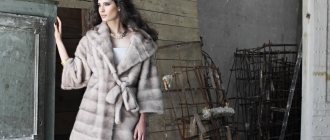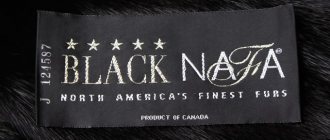12 Feb 2019
When buying fur outerwear, you may encounter a problem that unscrupulous sellers try to pass off an ordinary cheap fake as real mink. There are even “high-quality” options, when the buyer remains confident for some time after the purchase that he has become the owner of a real mink. But there are few of them. As a rule, you can distinguish the real skin of an expensive animal from fake dyed fur after the first contact with precipitation: at best, the cheap one will simply shed, at worst, it will shed and lose its shape, turning from a prestigious fur product into a large ball of wool. To prevent this from happening, you should know how to distinguish natural fur skins from high-quality and low-quality analogues.
The main differences between natural mink
Mink is highly valued in the world of fur products along with lynx and chinchilla. Every woman with refined taste and high demands in life dreams of having such a thing in her wardrobe. The fur of this animal is beautiful and durable, it looks expensive, presentable, and besides, it is really warm. A mink coat is characterized by excellent wear resistance: even in harsh climates, the wear life of the product is at least seven years, and with proper care it doubles. The quality and service life are affected by the age of the fur, what part of the skin is used (from the back of the fur coat is more expensive, from the belly and frontal part - cheaper) and the type of animal (European, American, Scandinavian and others). It is recommended to buy mink coats only in specialized boutiques, where the likelihood of encountering a fake is minimal. But even in a fashion boutique, the product should be carefully inspected and studied before purchasing. There are several criteria by which you can distinguish mink from a fake. It is equally important to be able to distinguish a mink from a rabbit and other animals by their fur. After all, fur is different from fur, and even a natural rabbit costs several times less than mink.
Comparison of skins of females and males
Recommendations from experts, as a rule, include a clause stating that it is inadmissible to mix the skins of females and males in one item.
| Characteristic | ?️ Female | ?️ Male |
| Leather base | The skin is thin and very elastic. | The skin is not as flexible as that of the female, its thickness is greater, and its texture is rougher. |
| Pile | The length of the guard hairs is shorter than that of the male's coat, and the undercoat is sparser. | The fur is more luxuriant than that of the female. The undercoat is abundant, dense, and the guard hairs are long and fluffy. |
| Weight | The skin is light, almost weightless. | The mass is greater than that of the female's skin. |
| Size | 5-10 square decimeters | 8-14 square decimeters |
As a rule, long fur coats are made from the skins of females. The skins of males are used to sew short fur products - jackets, cardigans, jackets, vests.
Which animals' fur becomes fake?
Mink fur is quite expensive.
To earn more, some unscrupulous sellers pass off fur coats made from rabbits, marmots and other animals as mink products. To do this, the fur can be cut, dyed, etc. But if the appearance of a fur coat can be easily changed, then it is not so easy, even impossible, to influence the properties of the fur. Different animals have fur that has its own distinctive features, which will help you distinguish a real mink from a fake. Instead of mink, scammers most often offer skins from:
- A rabbit. It has a very soft pile, the color is not the same and not uniform along the entire length of the product, and if you stroke the fur with your hand, lint remains on the palm.
- Beaver. It has fairly hard fur and a very thick interior.
- Groundhog. If you stroke the fur against the growth of the pile, it will become shaggy, since its plasticity index is minimal. In the sun a blue tint appears, the fur has different lengths.
- Ferret. The main difference is the color: the fur at the ends is darker, and the underfur is light. Only straight products are sewn from ferret fur, since in other cases the seams will be visible.
- Honorica. It is very difficult to distinguish the fur of natural honorica. The only thing that gives this animal away is its black color with a thick brown undercoat. Otherwise, this is the most perfect fake, because this animal was bred by crossing with the participation of mink.
In addition to natural animal fur, artificial fur coats can also act as fakes. Moreover, in response to the buyer’s remark that a mink coat looks strange, inventive scammers refer to the fact that this is a type of animal.
Should I buy a Chinese fur coat?
A factory-made Chinese fur coat is not at all a low-quality or low-grade product, as many people believe. Rather, on the contrary, fur from the Middle Kingdom is distinguished by its exquisite gray-blue fur color, and is inexpensive.
But it is Chinese fur coats that require utmost attention when purchasing, since stores often end up with not high-quality factory goods at all, but counterfeit ones, made in an artisanal way.
How to buy the right fur coat from the Middle Kingdom? The seller should be asked to present a quality certificate and study it carefully. The text of the document is presented in several languages; if the store gave you paper covered only with hieroglyphs, the item was either intended for sale on the domestic market or was hand-sewn. Of course, you need to carefully study the product itself.
Distinctive features of different types of mink
Depending on the origin (where the animal was raised), mink fur has a number of distinctive characteristics.
Thus, Russian mink is found mainly in long coats. The fur looks slightly shaggy, but has a natural shine and is silky to the touch. The pile is quite long and the undercoat is high. This fur coat is very warm, it can withstand any frost, warming its owner. You can distinguish it from a fake by the height of the middle layer of wool, which is significantly higher than the down. The Belarusian and Baltic species have the same characteristics as the Russian, although they are grown in other regions.
The most popular type of this fur animal is the Scandinavian one. This type is grown in Finland and Scandinavia. Depending on this, the fur can be low or high, but the undercoat is always very thick. There is another Scandinavian type of this animal, the so-called “polar”. Visually, this fur is more reminiscent of sable, since the pile is long, brown, and quite expensive. It is very warm, waterproof and has a wide range of colors (various shades of dark brown, up to black brown).
The North American species is represented exclusively by black fur. This fur is considered the most expensive, it is of impeccable quality, its underfur is very thick and dense. The pile in such products has a beautiful appearance, it is low and silky, in many ways reminiscent of velvet.
The most affordable in terms of pricing policy is Chinese mink fur. He has a long pile and a thick undercoat. Due to its high popularity, it is extremely rare to find original Chinese fur; fakes are becoming more and more common. All products are cut and can be dyed.
North American countries
It is very easy to check that this fur was grown on this continent, since it does not have a natural shine, and the pile is quite short in length. Mink products from these countries look like velvet. But, unfortunately, they are not very good for cold Russian winters. You can very easily check the authenticity of the product using the number indicated on the label. An example of such a fur coat is shown in the photo.
How to perform a fur assessment yourself?
A fake mink coat can be distinguished by a number of criteria. But to do this, you need to try the product by touch and carefully examine it from all sides.
- Try the fur to the touch. Not only touch it, but squeeze it in your fist, rub it. High-quality fur should be smooth and soft, but it will itch quite a bit. But rabbit fur does not prick at all (it can be distinguished from others by this criterion), it is very soft, but less wear-resistant. The pile should be pliable, but always return to its place after you run your hand over it. It is worth considering that if the fur is of high quality, it does not need dyeing or cutting. Such manipulations serve only to hide defects, but not to follow fashion. Only natural furs have always been and remain the most fashionable. Assess the undercoat. The mink is divided into winter and summer. The winter version is warmer, has a thick undercoat, and is cheaper. In summer-type fur, the opposite is true: the coat is smooth and shiny, and the undercoat is smaller. This type of fur is more expensive.
- Check the age of the fur. This can be done using the flesh. The light and elastic lower part of the skin indicates the youth of the fur, and the darker it is (even brown), the older it is.
- Visual assessment. The fur coat must have a uniform and even color, which makes it possible to distinguish a quality product. If the clothes are sewn from the back of the animal, then in appearance it will seem that the product is cast; if from the belly and other parts, the fur coat will seem to be sewn from small semicircles.
- Be sure to look under the lining. A quality item must be of high quality in everything. The lining must be sewn correctly: not too tightly, but not loose. The seams should be smooth and neat, and the edges should not stick out or protrude. And most importantly: with high-quality fur clothing, you can always look under the lining to evaluate the inside of the product. The fur on the inside should be white. It happens that during the manufacturing process it is overdried, then the underside of the fur becomes like tissue paper. This appearance may also indicate old age or stretched fur. At the first severe frost, the fur coat may immediately fall apart.
- Be careful with painted items. For some women, the fact that a fur coat is dyed is not an obstacle to purchase. But purchasing such products, as in the case of undyed fur, should only be purchased from a trusted seller who has the appropriate quality certificates. Otherwise, the dye from the fur may transfer to the clothes: with the first snow or rain, it will simply flow.
- Knowing these secrets, the buyer himself can evaluate the quality of the fur, which will help him distinguish a real mink coat.
How to distinguish a mink coat from a fake in practice?
The difference between a mink and a fake begins with its cost.
If they make you a very lucrative offer, offering a crazy 50-70% discount on a fur product (supposedly due to a sale), look for a catch - most likely, they are selling you a fake. The fur of an expensive animal cannot be cheap. The cost of the finished product, in addition to the cost of the fur itself, also includes the cost of tailoring, and working with fur, especially natural, requires a certain skill, which is also assessed accordingly. It is not recommended to buy fur products in unknown online stores without the right to try on and check the fur, where the buyer can distinguish a fake only after the purchase.
How can you verify the quality of a mink coat in practice? Here are a few life hacks on how to distinguish a mink coat from a fake:
- Shake the product, squeeze its edges, crumple the fur. This way you can determine whether the fur coat is rattling or whether it has been overdried.
- Examine the fur for creases. If they are present, this means that the product has holes.
- Gently tug the lint. It shouldn't be left in your hands.
- Check your armpit area. They should not be soft, as this indicates that someone has already worn this outerwear.
- The mink should have a uniform color. Otherwise, it is either faux fur or the hair of another animal.
- Try wiping the fur with a white napkin. Any traces on its surface will confirm that the product has been painted.
- Smell the fur. The smell of chemicals or dried animal fat may indicate that the fur processing process has been disrupted.
- Inspect the seams. They should be smooth and strong, using an elastic thread; ideally, the lining is sewn by hand.
- Check the label. It should contain detailed information about the country and place of production of the fur product, as well as contact details of the manufacturer.
Knowing how to distinguish a fake, you can purchase a quality product that will last for many years, decorating you and keeping you warm in any weather.

